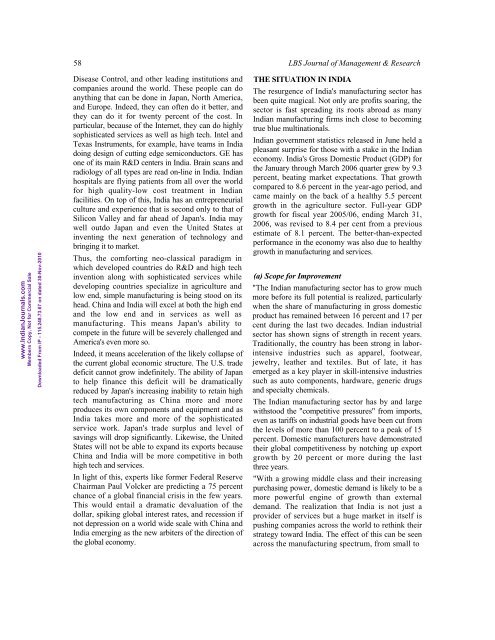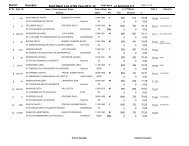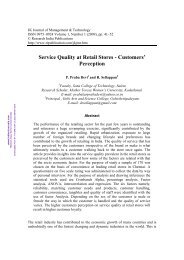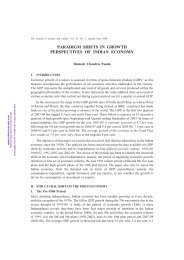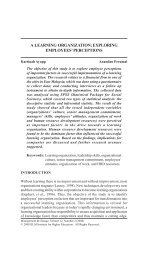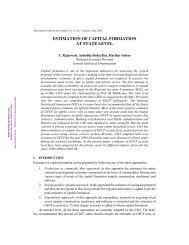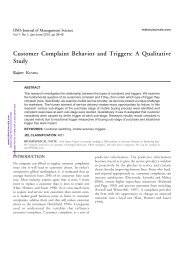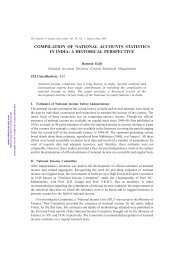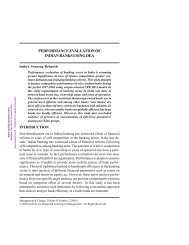20-India's Manufacturing Strategy - Global Perspective.pdf - Mimts.org
20-India's Manufacturing Strategy - Global Perspective.pdf - Mimts.org
20-India's Manufacturing Strategy - Global Perspective.pdf - Mimts.org
Create successful ePaper yourself
Turn your PDF publications into a flip-book with our unique Google optimized e-Paper software.
58 LBS Journal of Management & Research<br />
www.IndianJournals.com<br />
Members Copy, Not for Commercial Sale<br />
Downloaded From IP - 115.248.73.67 on dated 30-Nov-<strong>20</strong>10<br />
Disease Control, and other leading institutions and<br />
companies around the world. These people can do<br />
anything that can be done in Japan, North America,<br />
and Europe. Indeed, they can often do it better, and<br />
they can do it for twenty percent of the cost. In<br />
particular, because of the Internet, they can do highly<br />
sophisticated services as well as high tech. Intel and<br />
Texas Instruments, for example, have teams in India<br />
doing design of cutting edge semiconductors. GE has<br />
one of its main R&D centers in India. Brain scans and<br />
radiology of all types are read on-line in India. Indian<br />
hospitals are flying patients from all over the world<br />
for high quality-low cost treatment in Indian<br />
facilities. On top of this, India has an entrepreneurial<br />
culture and experience that is second only to that of<br />
Silicon Valley and far ahead of Japan's. India may<br />
well outdo Japan and even the United States at<br />
inventing the next generation of technology and<br />
bringing it to market.<br />
Thus, the comforting neo-classical paradigm in<br />
which developed countries do R&D and high tech<br />
invention along with sophisticated services while<br />
developing countries specialize in agriculture and<br />
low end, simple manufacturing is being stood on its<br />
head. China and India will excel at both the high end<br />
and the low end and in services as well as<br />
manufacturing. This means Japan's ability to<br />
compete in the future will be severely challenged and<br />
America's even more so.<br />
Indeed, it means acceleration of the likely collapse of<br />
the current global economic structure. The U.S. trade<br />
deficit cannot grow indefinitely. The ability of Japan<br />
to help finance this deficit will be dramatically<br />
reduced by Japan's increasing inability to retain high<br />
tech manufacturing as China more and more<br />
produces its own components and equipment and as<br />
India takes more and more of the sophisticated<br />
service work. Japan's trade surplus and level of<br />
savings will drop significantly. Likewise, the United<br />
States will not be able to expand its exports because<br />
China and India will be more competitive in both<br />
high tech and services.<br />
In light of this, experts like former Federal Reserve<br />
Chairman Paul Volcker are predicting a 75 percent<br />
chance of a global financial crisis in the few years.<br />
This would entail a dramatic devaluation of the<br />
dollar, spiking global interest rates, and recession if<br />
not depression on a world wide scale with China and<br />
India emerging as the new arbiters of the direction of<br />
the global economy.<br />
THE SITUATION IN INDIA<br />
The resurgence of <strong>India's</strong> manufacturing sector has<br />
been quite magical. Not only are profits soaring, the<br />
sector is fast spreading its roots abroad as many<br />
Indian manufacturing firms inch close to becoming<br />
true blue multinationals.<br />
Indian government statistics released in June held a<br />
pleasant surprise for those with a stake in the Indian<br />
economy. <strong>India's</strong> Gross Domestic Product (GDP) for<br />
the January through March <strong>20</strong>06 quarter grew by 9.3<br />
percent, beating market expectations. That growth<br />
compared to 8.6 percent in the year-ago period, and<br />
came mainly on the back of a healthy 5.5 percent<br />
growth in the agriculture sector. Full-year GDP<br />
growth for fiscal year <strong>20</strong>05/06, ending March 31,<br />
<strong>20</strong>06, was revised to 8.4 per cent from a previous<br />
estimate of 8.1 percent. The better-than-expected<br />
performance in the economy was also due to healthy<br />
growth in manufacturing and services.<br />
(a) Scope for Improvement<br />
"The Indian manufacturing sector has to grow much<br />
more before its full potential is realized, particularly<br />
when the share of manufacturing in gross domestic<br />
product has remained between 16 percent and 17 per<br />
cent during the last two decades. Indian industrial<br />
sector has shown signs of strength in recent years.<br />
Traditionally, the country has been strong in laborintensive<br />
industries such as apparel, footwear,<br />
jewelry, leather and textiles. But of late, it has<br />
emerged as a key player in skill-intensive industries<br />
such as auto components, hardware, generic drugs<br />
and specialty chemicals.<br />
The Indian manufacturing sector has by and large<br />
withstood the "competitive pressures" from imports,<br />
even as tariffs on industrial goods have been cut from<br />
the levels of more than 100 percent to a peak of 15<br />
percent. Domestic manufacturers have demonstrated<br />
their global competitiveness by notching up export<br />
growth by <strong>20</strong> percent or more during the last<br />
three years.<br />
"With a growing middle class and their increasing<br />
purchasing power, domestic demand is likely to be a<br />
more powerful engine of growth than external<br />
demand. The realization that India is not just a<br />
provider of services but a huge market in itself is<br />
pushing companies across the world to rethink their<br />
strategy toward India. The effect of this can be seen<br />
across the manufacturing spectrum, from small to


